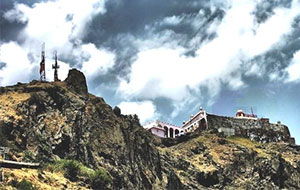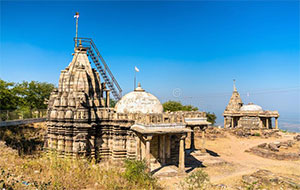The temples of Jainism at Pavagadh are also noteworthy. They fall into three different groups: The first consists of the Bhavanaderi temple near the Naqqarkhana gate called the Navalakka temples, the second group is in honour of the Tirthankaras Suparshvanatha and Chandraprabhu and the third group, situated on the south east of Pavagadh Hill (Mataji’s cliff), near the Pārśva temple.
On the basis of their “stylistic and architectural features”, the date of construction of these temples is deduced to be the 14th–15th centuries. The temples are made up of pure white stone with elaborately carved seated and standing images of the Jain pantheon on the outer walls.
The Pavagadh temples are famous for their architecture and are also part of the UNESCO World Heritage Site of Champaner-Pavagadh Archaeological Park. Pavagadh has three Jain temples complexes that includes a total of seven Jain temples, a dharamshala and an old-age home. The three Jain complexes are Bavanderi or Naulakhi temples, Chandraprabha and Suparshvanatha temple and group around Parshvanatha temple. Bavanderi Naulakhi temples are the ruins of subsidary shrine of once a large chaumukhi temple with entrance in four cardinal direction. The pillars inside the temple having carvings that bear a resemblance to Luna Vasahi. Chandraprabha and Suparshvanatha temple are two small temples built near Kalika Mata temple. Parshvanatha temple is the main temple in this group and surrounded by ruins of small temples.
These temples are visited by over 22 lakh visitors annually with 1 lakh devotees visiting daily during navaratri fair.





